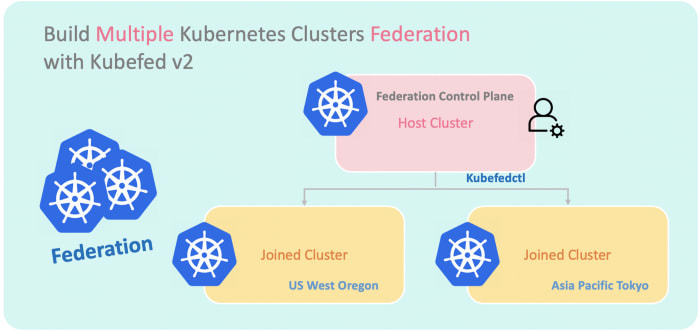Youtube Channel - https://www.youtube.com/watch?v=Uy1YACvm-is&t=3s
Build a Federation of Multiple Kubernetes Clusters With Kubefed V2
A step-by-step guide to building a Kubernetes federation for managing multiple regions’ clusters with KubeFed
image
What Is KubeFed?
KubeFed (Kubernetes Cluster Federation) allows you to use a single Kubernetes cluster to coordinate multiple Kubernetes clusters. It can deploy multiple-cluster applications in different regions and design for disaster recovery. To learn more about KubeFed: https://github.com/kubernetes-sigs/kubefed
Prerequisites
Kubernetes clusters must be up and running: kubernetes v1.13+. In this article, we’ll have three Kubernetes clusters. One is for installing Federation Control Plane as the host cluster (context named zone). The others are for deploying applications named us-west-oregon (context named lab-a) and asia-pacific-tokyo (context named lab-b).
KubeFed CLI Installation
https://github.com/kubernetes-sigs/kubefed/releases
wget https://github.com/kubernetes-sigs/kubefed/releases/download/v0.8.1/kubefedctl-0.8.1-linux-amd64.tgz
tar -zxvf kubefedctl-*.tgz
chmod u+x kubefedctl
sudo mv kubefedctl /usr/local/bin/ #make sure the location is in the PATH
You can check your kubefedctl version via:
kubefedctl version
image
KubeFed Installation
KubeFed installation uses Helm chart for deployment. In the host cluster, you can use the following command to install Helm CLI Helm v3
wget -O helm.tar.gz https://get.helm.sh/helm-v3.5.4-linux-amd64.tar.gz
tar -zxvf helm.tar.gz
sudo mv linux-amd64/helm /usr/local/bin/helm
helm
helm repo add stable https://charts.helm.sh/stable
Install KubeFed v0.8.1 in kube-federation-system namespace (default) with the following command:
git clone https://github.com/kubernetes-sigs/kubefed.git
cd kubefed/charts/kubefed/
kubectl create namespace kube-federation-system
helm install kubefed . --namespace kube-federation-system
kubectl get pod -n kube-federation-system
image
Cluster Registration
In the host cluster, set up Kubectl config for lab-a and lab-b, so we’ll be able to access those clusters via a context switch and use the context to join the federation:
Refer - https://kubernetes.io/docs/tasks/access-application-cluster/configure-access-multiple-clusters/ and follow the steps
(OR)
Replace CLUSTERNAME, CLUSTERIP, USERNAME, TOKEN, CONTEXTNAME
kubectl config set-cluster CLUSTERNAME --server=CLUSTERIP
kubectl config set-credentials USERNAME --token="TOKEN"
kubectl config set-context CONTEXTNAME --cluster=CLUSTERNAME --user=USERNAME
Check the contexts for all clusters:
kubectl config get-contexts
kubectl config use-context
image
Use kubefedctl join to register clusters into the host cluster:
Replace JOINED_CLUSTER_NAME, HOST_CLUSTER_NAME, HOST_CLUSTER_CONTEXT, JOINED_CLUSTER_CONTEXT
kubefedctl join JOINED_CLUSTER_NAME --host-cluster-name=HOST_CLUSTER_NAME --host-cluster-context=HOST_CLUSTER_CONTEXT --cluster-context=JOINED_CLUSTER_CONTEXT
example:
kubefedctl join us-west-oregon --host-cluster-name=host-cluster --host-cluster-context=zone --cluster-context=lab-a
kubefedctl join asia-pacific-tokyo --host-cluster-name=host-cluster --host-cluster-context=zone --cluster-context=lab-b
After you’ve joined clusters, you can check the status via the below command:
kubectl -n kube-federation-system get kubefedclusters
image
Awesome!! Your federation clusters are ready now.
Deploy Nginx Service
cat << EOF | kubectl apply -f -
apiVersion: v1
kind: Namespace
metadata:
name: test-namespace
EOF
cat << EOF | kubectl apply -f -
apiVersion: types.kubefed.io/v1beta1
kind: FederatedNamespace
metadata:
name: test-namespace
namespace: test-namespace
spec:
placement:
clusters:
- name: us-west-oregon
- name: asia-pacific-tokyo
EOF
cat << EOF | kubectl apply -f -
apiVersion: types.kubefed.io/v1beta1
kind: FederatedDeployment
metadata:
name: test-deployment
namespace: test-namespace
spec:
template:
metadata:
labels:
app: nginx
spec:
replicas: 3
selector:
matchLabels:
app: nginx
template:
metadata:
labels:
app: nginx
spec:
containers:
- image: nginx
imagePullPolicy: IfNotPresent
name: nginx
placement:
clusters:
- name: us-west-oregon
- name: asia-pacific-tokyo
EOF
After deployment, you will be able to see the nginx deployments are up and running in both clusters.
Check for lab-a
kubectl get deployment -n test-namespace -owide --context lab-a
Check for lab-b
kubectl get deployment -n test-namespace -owide --context lab-b
image
You can also override application deployment version, etc., for specific clusters only via defining overrides in the YAML file :
cat << EOF | kubectl apply -f -
apiVersion: types.kubefed.io/v1beta1
kind: FederatedDeployment
metadata:
name: test-deployment
namespace: test-namespace
spec:
template:
metadata:
labels:
app: nginx
spec:
replicas: 3
selector:
matchLabels:
app: nginx
template:
metadata:
labels:
app: nginx
spec:
containers:
- image: nginx
name: nginx
placement:
clusters:
- name: us-west-oregon
- name: asia-pacific-tokyo
overrides:
- clusterName: asia-pacific-tokyo
clusterOverrides:
- path: "/spec/replicas" value: 5
- path: "/spec/template/spec/containers/0/image" value: "nginx:1.17.0-alpine"
- path: "/metadata/annotations" op: "add" value: foo: bar
- path: "/metadata/annotations/foo" op: "remove" EOF After deployment, you’ll be able to see that the nginx deployment’s replicas, image version, etc., in lab-a are now modified.
Check for lab-a
kubectl get deployment -n test-namespace -owide --context lab-a
Check for lab-b
kubectl get deployment -n test-namespace -owide --context lab-b
That’s all for the application deployment testing. Now you’ll be able to use the federation to manage your clusters and application!



Top comments (0)